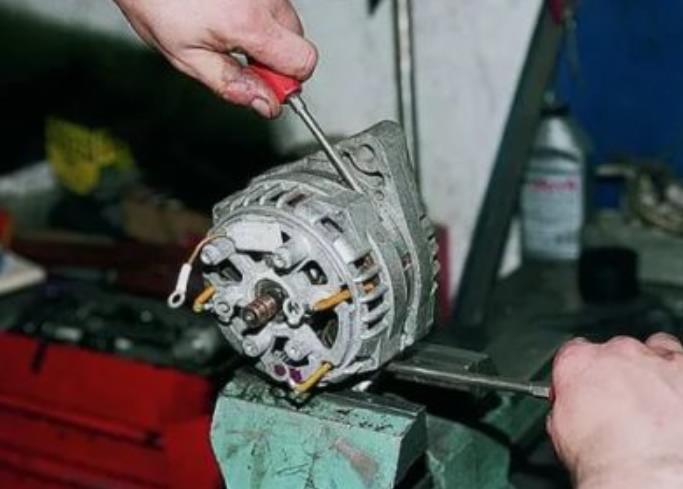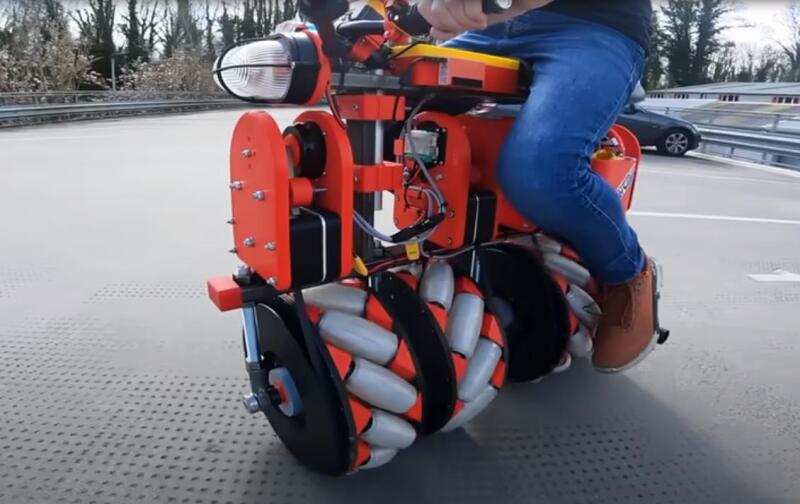If you know how to use a soldering iron, and are able to remove the generator from the car, you can say with a high degree of probability that you will succeed. But not a fact.
Generator device
Of course, it is desirable to have at least a figurative idea of how this node is arranged. The car generator consists of the following main parts:
- ? Collapsible housing
- ? Drive shaft with pulley
- ? Shaft bearings
- ? Rotor with excitation winding and slip rings
- ? Stator with winding and magnetic core
- ? brush knot
- ? Rectifier block
- ? Voltage regulator
The generator generates electric current while the car is moving, recharges the battery and feeds the on-board network. Incorrect operation of the unit can not only de-energize the car, but also lead to damage to the wiring, battery and BC. But let's talk about this in more detail.
Symptoms of malfunctions
It is possible to determine the presence of problems with the generator without special instruments. To do this, the owner should pay attention to such characteristic symptoms:
- ? Extraneous noise during operation of the node
- ? Lack of charging current on the battery (indicator on the dashboard is on)
- ? Recharging the battery - boiling off the electrolyte, heating
- ? Undercharging - the battery can not cope with starting the starter
- ? Weak headlights
- ? Changing the brightness of lighting devices with an increase in the number of revolutions
- ? The rattling sound of the horn when the engine is running
The appearance of any of these signs indicates the need for an audit. If you ignore the bells, subsequent repairs may be more costly. And the prospect of a sudden generator failure somewhere on the highway between cities is not encouraging. In the summer, all right, you’ll just lose time and money on a tow truck, and in winter you won’t freeze for long in a non-working car.
Possible problems
So, let's discuss the most common generator failures. One way or another, all drivers have encountered something from our list. Unless novice motorists and owners who change cars every two to three years for new ones can boast of their ignorance. For the rest, I offer a small list for memories:
- ? Wear of graphite brushes. They transmit exciting current to the rotor. due to wear, the contact between the rings and brushes becomes unstable, and the risk of failure of the contact group on the rotor increases
- ? Voltage regulator failure. Provides voltage stability in the on-board network and charging voltage
- ? Rectifier failure.. The diode bridge converts the alternating current of the generator into direct current. It is enough to burn at least one diode for the generator to fail.
- ? Bearing wear. Wear can cause thrust bearings to seize or fail, resulting in damage to the shaft and the entire generator.
- ? Belt slippage. The belt drive must not sag. Weak tension leads to failure of the bearings, interruptions in the operation of the generator
The last case is the most comfortable in terms of work. Simply tighten the belt or replace with a new one. This process is not laborious and does not require special skills. In one of the articles on Bibimot, we will definitely highlight its replacement on our own in all details.
 First, the generator must be removed from the car. Photo: youtube.com
First, the generator must be removed from the car. Photo: youtube.com In any case, all of the listed faults can be eliminated by replacing the failed elements. If there was a mechanical destruction of the case, the generator is usually beyond repair - the owner will have to buy a new one or from disassembly.
When the windings on the stator or rotor burn out, new ones are wound. But not on your own. These works must be performed by a qualified specialist, and they are not cheap.
In some cases, it makes sense to compare investments and possible risks of re-burnout due to insufficient quality of the conductor products used for rewinding.
More precise check
So, you suspect something, and are ready to master the art of restoring the generator's performance yourself (you have extra time and a set of necessary tools). Generator diagnostics at home is usually carried out in two main ways. The first method is somewhat outdated and applies exclusively to generators installed on old carburetor-type cars (in a word, the last century!).
 Checking the generator windings. Photo: youtube.com
Checking the generator windings. Photo: youtube.com To check, start the engine and disconnect the negative terminal from the battery. If there are no failures in the operation of electrical equipment, this indicates that there is no reason for unrest. In any case, your generator performs its tasks, be healthy!
A modern car needs a more thoughtful approach. You will need a special device - a multimeter. The tester is set to measure DC voltage in the range from 0 to 20 V. With the engine turned off, the probes are applied to the battery contacts: black - to negative, red - to positive. The readings of the device with a working battery are 12,5 V.
Then, with the multimeter connected, start the engine. If the alternator is in working order, the battery will begin to recharge, with a corresponding increase in voltage. Under normal conditions, this characteristic should increase to 14,5 V. The failure of the generator is indicated by a voltage below 13 V or above 14,8 V.
With the engine idling, add load to the battery. Turn on the wipers, radio, lights, heated windows, etc.
If the voltage drops below 13 V, this indicates problems in the operation of the generator.
The condition of the bearings can be checked by removing the drive belt from the pulley and turning the shaft by hand. Breakage is determined by the characteristic noise of the balls, slight wedging or vertical play. A slight runout is not at all the norm, but rather evidence of a critical degree of wear.
How to disassemble the assembly and make repairs
To disassemble the generator, you first need to remove it, and this is another puzzle. It all depends on the specific model of the car, but in any case, you should have wrenches (open-end and box wrenches), ratchet heads, an extension with a collar at hand.
 The main thing is not to lose small elements. Photo: youtube.com
The main thing is not to lose small elements. Photo: youtube.com After the generator is in your hands, prepare a workplace (a table is best) and several sheets of paper on which you will lay out the internal contents of the device. It will be a shame if you do everything right, but you lose some small detail, without which you can’t.
Work is performed in the following sequence:
- ? Turn off the ignition, unplug one of the battery terminals
- ? Removing the generator from the car
- ? Removing the back cover
- ? Soldering the stator winding from the rectifier unit and voltage regulator
- ? Removing the rectifier unit, relay and brush assembly
- ? Dismantling the drive pulley (pay attention to the safety of the buffer bushings) and the front cover of the generator
- ? Removing the rotor and stator shaft (to remove the cover from the stator assembly, disconnect the contacts at the connection of the phase windings to the diode bridge)
After that, you should focus on troubleshooting. The condition of each of the elements is assessed, the diodes are called, the contact groups are cleaned of dirt and oxide. Elements with obvious wear above average are ruthlessly replaced with new ones. Also, do not forget to check the insulation resistance value on the excitation winding with the device. We compare the result with the data in the car's operating manual.
If the winding breaks or shorts, as indicated by a deviation in the resistance value, it will need to be replaced. If individual contacts are unsoldered, we unwind the coil, removing the faulty segment, and restore the damaged connection.
After eliminating all the shortcomings, we assemble the unit in the reverse order.
 Putting it back together correctly is another challenge. Photo: youtube.com
Putting it back together correctly is another challenge. Photo: youtube.com It is necessary to securely fix the fasteners, and at the same time avoid excessive force. When using a screwdriver, it is not necessary to tighten the elements to the stop. The final tightening of the wire connections by hand - this will be calmer.
Maintenance procedure
Proper care and maintenance is essential to keep the generator set running longer than usual. As the owner, you are required to regularly perform the following operations:
- ? Checking the tension of the drive belt - if the tension is insufficient, the pulley will slip, and excessive force causes an increased load on the bearings;
- ? Blowing with compressed air to remove dust and dirt - several times a year
- ? Cleaning contacts - the reliability of the connections affects the performance of the equipment. Terminals are regularly cleaned of oxidation, damaged elements are changed
- ? Replacement of brushes - as they wear out, from 50% and above
To ensure long-term operation of the generator unit, it is better not to save money when replacing, and buy original components, with a quality guarantee, and from trusted suppliers.
Despite the fact that the generator is not among the main units, its failure will not allow you to move on. Knowing the signs that indicate a node malfunction will allow you to fix the problem in a timely manner before a critical stage occurs. Actually, that's what this article is for. Good luck on the roads!










